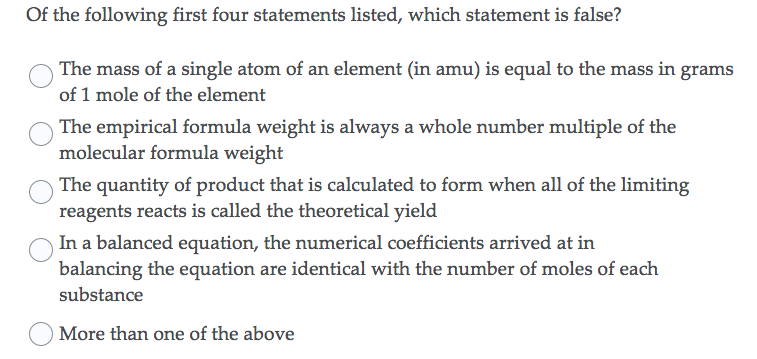The mass of a single atom of an element (in amu) is equal to the mass in grams of 1 mole of the element The empirical formula weight is always a whole number multiple of the molecular formula weight The quantity of product that is calculated to form when all of the limiting reagents reacts is called the theoretical yield In a balanced equation, the numerical coefficients arrived at in balancing the equation are identical with the number of moles of each substance More than one of the above
The mass of a single atom of an element (in amu) is equal to the mass in grams of 1 mole of the element The empirical formula weight is always a whole number multiple of the molecular formula weight The quantity of product that is calculated to form when all of the limiting reagents reacts is called the theoretical yield In a balanced equation, the numerical coefficients arrived at in balancing the equation are identical with the number of moles of each substance More than one of the above
World of Chemistry, 3rd edition
3rd Edition
ISBN:9781133109655
Author:Steven S. Zumdahl, Susan L. Zumdahl, Donald J. DeCoste
Publisher:Steven S. Zumdahl, Susan L. Zumdahl, Donald J. DeCoste
Chapter9: Chemical Quantities
Section: Chapter Questions
Problem 67A
Related questions
Question

Transcribed Image Text:Of the following first four statements listed, which statement is false?
The mass of a single atom of an element (in amu) is equal to the mass in grams
of 1 mole of the element
The empirical formula weight is always a whole number multiple of the
molecular formula weight
The quantity of product that is calculated to form when all of the limiting
reagents reacts is called the theoretical yield
In a balanced equation, the numerical coefficients arrived at in
balancing the equation are identical with the number of moles of each
substance
O More than one of the above
Expert Solution
This question has been solved!
Explore an expertly crafted, step-by-step solution for a thorough understanding of key concepts.
This is a popular solution!
Trending now
This is a popular solution!
Step by step
Solved in 2 steps

Knowledge Booster
Learn more about
Need a deep-dive on the concept behind this application? Look no further. Learn more about this topic, chemistry and related others by exploring similar questions and additional content below.Recommended textbooks for you

World of Chemistry, 3rd edition
Chemistry
ISBN:
9781133109655
Author:
Steven S. Zumdahl, Susan L. Zumdahl, Donald J. DeCoste
Publisher:
Brooks / Cole / Cengage Learning

World of Chemistry
Chemistry
ISBN:
9780618562763
Author:
Steven S. Zumdahl
Publisher:
Houghton Mifflin College Div

Chemistry by OpenStax (2015-05-04)
Chemistry
ISBN:
9781938168390
Author:
Klaus Theopold, Richard H Langley, Paul Flowers, William R. Robinson, Mark Blaser
Publisher:
OpenStax

World of Chemistry, 3rd edition
Chemistry
ISBN:
9781133109655
Author:
Steven S. Zumdahl, Susan L. Zumdahl, Donald J. DeCoste
Publisher:
Brooks / Cole / Cengage Learning

World of Chemistry
Chemistry
ISBN:
9780618562763
Author:
Steven S. Zumdahl
Publisher:
Houghton Mifflin College Div

Chemistry by OpenStax (2015-05-04)
Chemistry
ISBN:
9781938168390
Author:
Klaus Theopold, Richard H Langley, Paul Flowers, William R. Robinson, Mark Blaser
Publisher:
OpenStax

Chemistry: Matter and Change
Chemistry
ISBN:
9780078746376
Author:
Dinah Zike, Laurel Dingrando, Nicholas Hainen, Cheryl Wistrom
Publisher:
Glencoe/McGraw-Hill School Pub Co

Introductory Chemistry: An Active Learning Approa…
Chemistry
ISBN:
9781305079250
Author:
Mark S. Cracolice, Ed Peters
Publisher:
Cengage Learning
